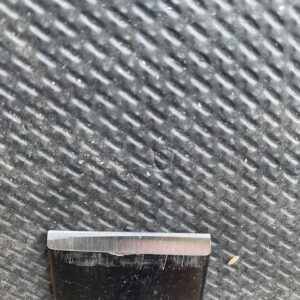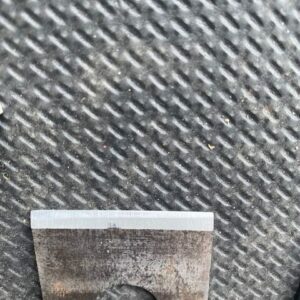I’ve recently started to sharpen my own plane blades and chisels. I have a woodpecker honing jig and 400, 1000, 3000 and 8000 grit wet stones. My problem is that as I hone the blade, it skews. No matter what I do, it comes out uneven. I’ve replicated this with 2 different blades on all of my stones including some sandpaper on melamine. I’ve also used 2 different jigs. The blade always comes uneven. The only common denominator is me. I’m at a loss. There’s not a lot to the jigs and they appear to be pretty straight. Can anyone point me in the right direction of a website or resource? All of my searches end with how to sharpen a blade, but I cannot find anything on my specific problem. Also, I’ve squared the blades with my grinder, too. Thanks.
Discussion Forum
Get It All!
UNLIMITED Membership is like taking a master class in woodworking for less than $10 a month.
Start Your Free TrialCategories
Discussion Forum
Digital Plans Library
Member exclusive! – Plans for everyone – from beginners to experts – right at your fingertips.
Highlights
-
Shape Your Skills
when you sign up for our emails
This site is protected by reCAPTCHA and the Google Privacy Policy and Terms of Service apply. -
 Shop Talk Live Podcast
Shop Talk Live Podcast -
 Our favorite articles and videos
Our favorite articles and videos -
E-Learning Courses from Fine Woodworking
-
-
 Fine Woodworking New England Event
Fine Woodworking New England Event -














Replies
What kind of stones and do you flatten them?
I have a sharp pebble large flattening stone with dual grit. I have to UUP whetstone sharpened kit. I’ve also got a cheap Diamond stone.
Are you right handed? Could be you are using more pressure with your dominant hand. Looks like with the bevel down the right side is getting more pressure then the left. Just a possibility.
Is your Woodpecker jig one of those with two brass wheels, one at either side of the jig; or a version with a single central wheel?
If the former, its likely that you're not putting the blade into the jig exactly square. If the latter, you may be pressing more on one side of the blade as you sharpen than on the other side, as another poster mentions.
It's also possible that your jig is not itself properly made. For example, one brass wheel in the two-wheel version may have a slightly larger diameter than the other. Or the blade bed may not be flat or at the right (square) angle to the rest of the jig.
The grip of the jig on the sides of the blade may also be uneven, forcing the blade to skew slightly from the initial square angle as you sharpen.
A fourth possibility is that your blades are not evenly thick - but this is unlikely if you're using modern blades of a reasonable quality.
I'll try to answer questions from both posts: I am right handed and thought about me possibly dispersing the weight unevenly. I got to a point where I was putting all of the pressure on one side to compensate...with no luck. I have the "honing system", which means its a guide (with 2 independent wheels that are adjustable (they can be moved inside or outside- wheels on outside for chisels and inside for plane blades). It also has a separate adjustable piece to fit the jig to the exact angle.
In terms of putting it in "exactly square", this is one of the perplexing areas. I've followed all the manufacturer instructions to the letter. There aren't a lot of moving pieces to get crooked. I've lined up a machinest square on both sides and its square. (Also, this is happening with 2 separate blades).
Wheel thickness. Thanks for the suggestion. I pulled them off and measured them with marking gauge (worked pretty well seeing I don't have calipers) and they were the same.
As far as the whole jig being off and listing to one side, the best that I can do is eyeball it and it looks pretty straight. Plus, would I have bought 2 jigs that are both off in the same direction?
Blade thickness: I measured both blades with the marking gauge and they are pretty spot on.
Last observation: Since the blades can be inserted into the jig from both sides, wouldn't the unevenness be reversed depending which side I put the blade into the jig. This is true for both jigs.
I'm at a point where I'm looking for local woodworking shops/schools to visit in person, but I haven't found one yet.
Thanks again for the feedback!
Suggestion #1: Go to RobCosman.com
He has a video called "32 Seconds to Sharp." If you aren't a member it might cost you a coupla bucks to download it. He'll teach you how to sharpen by hand without jigs. Takes some practice but gives you a lifetime skill. Then get some HIGH QUALITY (not a brand I'm suggesting ,a quality )diamond stones. One with a 500 grit on one side and 1000 on the other side. Plus a 16,000 grit Shapton ceramic stone. Expensive but again almost a lifetime investment. Toss out your jigs and whetstones.
Suggestion #2: If the foregoing isn't of interest buy a Veritas Honing jig but still get some high quality diamond stones as above and toss out your whetstones.
Cutting perfect dovetails by hand takes practice, as does sharpening.
Thank you so much.
I can sharpen freehand. I can sharpen carving tools of every profile by hand as well. Sharpening plane blades and chisels freehand is just not as fast, accurate, or repeatable as using a jig. I'd never be without my Lie Nielsen jig. I have no idea what the Woodpecker jig is, how to use it, or anything else, so I won't comment on it.
Sharpening takes time and practice and you will get better at it. You will make observations like you are doing and will make adjustments. Eventually you will get better.
For what it's worth, the adjustment lever on a hand plane should help negate the skew you are seeing on the blade so that you are getting an even thickness shaving across the whole blade.
I recommend you refer to this link:
https://www.finewoodworking.com/project-guides/hand-tools/sharpening-systems-explained
I have been sharpening since the late 80’s. I evolved from Arkansas stones to diamond stones to water stones and now I use ceramic exclusively. I used to laugh at folks that used any grit finer than 8k. I use 16k stones and they are phenomenal.
I adopted the principles laid out in this series and I have never had sharper tools nor have I ever sharpened so fast.
From the pictures, it looks like you are putting more pressure on the right side than the left while sharpening. I don't know the wood peckers jig at all, but it may be the operator, or the set up of the jig.